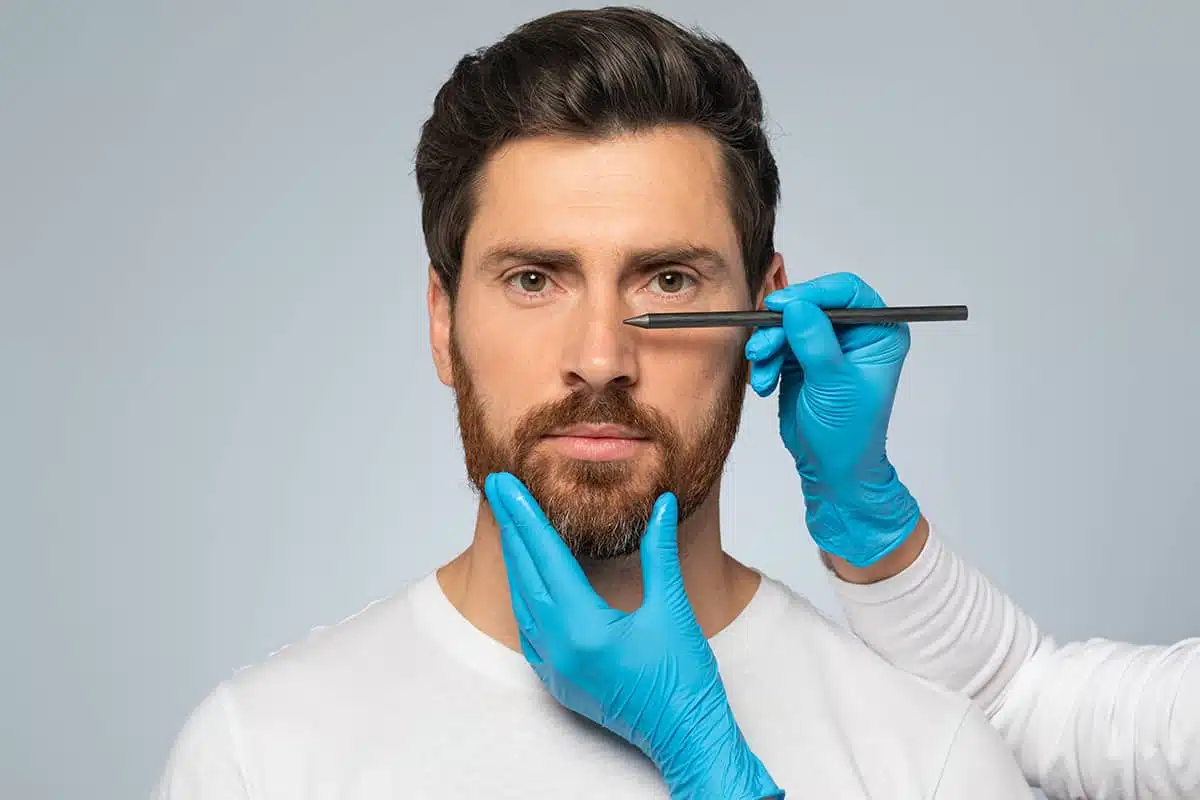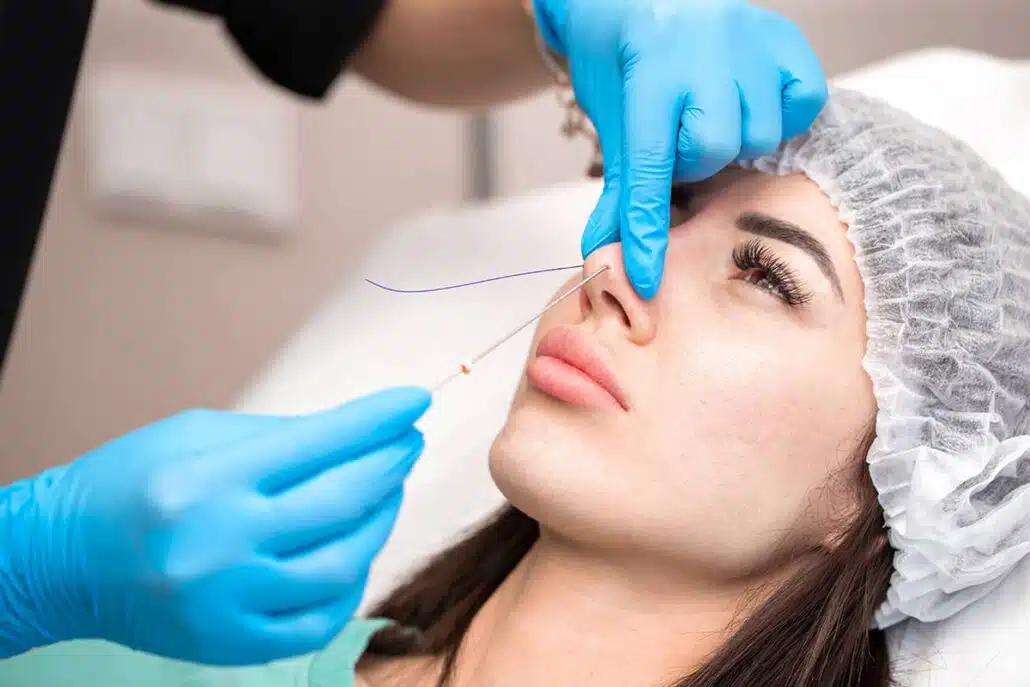Nose Job Alternatives to Consider

Are you curious about reshaping your nose but hesitant to go under the knife? Whether you’re unsure about surgery or just looking for subtle enhancements, nose job alternatives are gaining popularity as minimally invasive ways to improve nasal appearance.
From temporary tweaks to subtle improvements, today’s non-surgical options offer more flexibility than ever before. But how do they compare to traditional rhinoplasty, and are they right for you? Let’s take a closer look at what’s available—and when surgery might still be the smarter move.
Can you get a rhinoplasty without surgery?
Yes, it is possible to achieve rhinoplasty-like results without surgery. Non-surgical rhinoplasty—often referred to as a liquid nose job—is a procedure that uses dermal fillers to reshape the nose. While it doesn’t offer permanent or structural changes, it can be a great choice for those looking to smooth small bumps or lift the nasal tip. However, surgical rhinoplasty remains the gold standard for significant corrections or functional improvements. In this article, we’ll walk you through the top alternatives and when they make the most sense.
Liquid Rhinoplasty
Liquid rhinoplasty, also known as a non-surgical nose job, has quickly become a popular alternative for patients seeking subtle nasal enhancements without the commitment or recovery time of surgery. This in-office procedure typically involves the use of hyaluronic acid-based dermal fillers (and sometimes Botox) to smooth out minor bumps, refine the nasal bridge, or lift the tip of the nose. With virtually no downtime and results that are visible almost immediately, it’s no wonder why more and more individuals are considering this minimally invasive route.
While injectable fillers are not a replacement for rhinoplasty surgery in every case, it does open up new aesthetic possibilities for those looking for temporary or modest changes. To help you decide if this could be the right approach for you, let’s break down some of the key benefits and potential drawbacks.
Liquid Nose Job Benefits
For individuals looking for a less invasive way to enhance the shape of their nose, a liquid nose job offers several compelling advantages. While the results aren’t permanent, the convenience and speed of the procedure make it an attractive option for many. Here are some of the key benefits:
- Minimally Invasive: Liquid rhinoplasty doesn’t require incisions, anesthesia, or stitches. The procedure involves just a few injections, making it ideal for those who prefer to avoid surgery altogether.
- Little to No Downtime: Most patients can return to their normal activities immediately after the procedure. There’s usually minor swelling or bruising, but nothing compared to the recovery involved in traditional nose surgery.
- Immediate Results: Unlike surgical rhinoplasty, which requires months to see final results, the effects of dermal fillers are visible almost instantly—perfect for those seeking quick aesthetic improvements.
- Adjustable and Temporary: Because it’s not permanent, patients have the flexibility to fine-tune their look over time or reverse the changes entirely if they choose to.
- Cost-Effective in the Short Term: While not a long-term substitute, liquid rhinoplasty typically costs significantly less than surgical rhinoplasty, making it more accessible for those exploring aesthetic options for the first time.
Liquid Nose Job Drawbacks
While a liquid nose job offers many appealing benefits, it’s not without its limitations. Understanding these drawbacks can help set realistic expectations and determine whether this non-surgical option is the right fit for you:
- Temporary Results: Dermal fillers typically last between 6 months to 2 years, depending on the product used and your body’s metabolism. This means regular touch-ups are necessary to maintain the look.
- Limited Scope of Correction: Liquid rhinoplasty can only address minor cosmetic concerns. It cannot correct structural deformities, breathing issues, or make the nose smaller—issues that require surgical intervention.
- Risk of Vascular Complications: Though rare, improper injection techniques can lead to serious complications, including vascular occlusion. This highlights the importance of choosing an experienced provider.
- No Functional Improvement: Unlike surgical rhinoplasty, non-surgical approaches cannot address issues like a deviated septum or nasal obstruction. It is purely cosmetic.
- May Mask the Real Problem: In some cases, fillers can temporarily camouflage an issue that actually needs surgical correction, delaying the inevitable need for surgery.
Secure Your Safe Treatment Experience with Dr. Daniel G. Becker.
Join our satisfied clients who’ve experienced safe, effective treatments.
Nose Thread Lift
The nose thread lift is an innovative, non-surgical alternative for those looking to enhance the shape and contour of their nose without the downtime and permanence of traditional rhinoplasty. This minimally invasive technique involves inserting medical-grade threads—usually made of PDO or PCL—into the nasal tissue, where they are gently pulled to lift and support the desired shape. The threads are anchored in place and gradually dissolve over time, stimulating collagen production in the process.

Because the treatment can be performed under local anesthesia and completed in under an hour, it appeals to patients who want noticeable yet subtle changes without a lengthy recovery. It’s especially popular among individuals seeking a more defined nasal bridge or tip projection. While results are not permanent, they can last up to a year or more, depending on the thread type and the patient’s skin condition. Let’s explore the pros and cons of this trending procedure to help determine if it might be the right choice for your cosmetic goals.
Nose Thread Lift Benefits
For patients who want a more structured or lifted nasal appearance without permanent changes, a nose thread lift can be a highly effective option. This procedure provides noticeable improvement with minimal interruption to daily life. Here are the standout benefits:
- Minimally Invasive with No Surgery: The treatment avoids any incisions or tissue removal. It uses fine threads inserted beneath the skin to lift and shape the nose, making it a gentler option for those hesitant about surgery.
- Quick Procedure Time: Most nose thread lifts can be completed in under an hour, often during a standard office visit, making it convenient for people with busy schedules.
- No Downtime: Recovery is swift, with many patients returning to work or normal activities within a day. Mild swelling or bruising is common but usually fades quickly.
- Natural-Looking Results: The lift is subtle, helping refine and support the nasal structure without overcorrection. It enhances the nose while preserving natural contours.
- Long-Lasting Effects: Results can last up to a year or longer, especially when high-quality threads are used and good skin quality is present.
- Collagen Stimulation: As the threads dissolve, they stimulate collagen production, potentially offering improved skin texture and firmness over time.
Nose Thread Lift Drawbacks
Despite its appeal, a nose thread lift is not without its limitations and potential complications. Understanding these drawbacks will help ensure realistic expectations and safer decision-making:
- Temporary Results: Similar to dermal fillers, the results of a thread lift are not permanent. The threads naturally dissolve over time, and while collagen stimulation may extend the effects, most patients need repeat treatments within 12 to 18 months.
- Risk of Thread Migration: Although rare, threads can sometimes shift from their original placement. While this is often correctable, it can affect the symmetry or intended result.
- Limited Reshaping Capability: Thread lifts are best suited for mild contouring or subtle lifting. They cannot address major structural changes or functional issues such as breathing difficulties.
- Mild Side Effects: Some patients experience swelling, bruising, numbness, or tenderness around the treatment area. These effects are usually temporary but can be uncomfortable.
- Possibility of Infection: As with any procedure that involves breaking the skin, there is a slight risk of infection. Choosing a qualified, experienced provider minimizes this risk significantly.
When is a Surgical Nose Job the Best Option?
While non-surgical options like liquid rhinoplasty and nose thread lifts offer fast, subtle results with minimal downtime, they aren’t suitable for everyone. There are specific scenarios where a traditional surgical nose job is the more appropriate—and sometimes necessary—choice.
- Significant Nasal Deformities: If your nose has noticeable structural irregularities—whether from trauma, genetics, or previous surgeries—non-surgical methods simply won’t provide the correction needed. Surgery allows for precise reshaping and long-lasting results.
- Severe Breathing Issues: Conditions like a deviated septum or collapsed nasal valves often require internal correction that can only be addressed surgically. Functional rhinoplasty not only improves the look of the nose but restores proper airflow.
- Desire for Permanent Results: While fillers and threads are temporary, surgical rhinoplasty offers results that can last a lifetime with proper care, making it a more cost-effective solution in the long term for those seeking a definitive change.
- Extensive Reshaping Needs: Non-surgical methods are limited to minor contour changes. For individuals who want major alterations—such as reducing nose size or altering nostril shape—surgery is the only option that can deliver those results.
- Unsatisfactory Results from Non-Surgical Procedures: If previous attempts with fillers or threads didn’t achieve your goals or created complications, surgical intervention may be required to correct or refine your nasal structure.
Ultimately, determining the best path forward starts with a comprehensive consultation. Speaking with a qualified plastic surgeon ensures that your concerns are properly evaluated and matched to the most effective treatment. Personalized advice from an expert can help you weigh the pros and cons of each option, setting you on the right path toward results you’ll love.
Cost Comparison Between Traditional Rhinoplasty and Alternative Procedures
When considering a nose job, cost is often a major factor in the decision-making process. Traditional rhinoplasty is a more complex and permanent procedure, which is reflected in its higher price tag. According to data from RealSelf, the average cost of surgical rhinoplasty is around $11,064, but prices can range anywhere from $4,125 to $22,000 depending on the surgeon’s experience, geographic location, general anesthesia, and the complexity of the surgery.
In contrast, liquid rhinoplasty—which uses dermal fillers—offers a much more budget-friendly option. It typically costs an average of $1,287, with a general range between $495 and $2,850. While the results aren’t permanent and touch-ups are needed to maintain them, the lower upfront cost makes it accessible for many first-time patients.
The nose thread lift falls in between, both in cost and permanence. This procedure generally ranges from $1,500 to $3,000, depending on the type and number of threads used. Though slightly more expensive than liquid rhinoplasty, the results tend to last a bit longer and provide a more lifted effect.
It’s important to weigh these costs against the longevity and limitations of each option. While non-surgical alternatives are more affordable initially, the need for repeat treatments can add up over time. Surgical rhinoplasty may be a larger investment upfront, but it offers permanent results that can save money in the long run.
Schedule a Consultation with an Expert Rhinoplasty Surgeon
Choosing an experienced facial plastic surgeon for any type of nose reshaping—surgical or not—is crucial. Expertise ensures that your results are not only visually appealing but also safe, functional, and tailored to your unique facial structure. An expert can also guide you toward the best option for your goals, whether it’s temporary enhancement or a permanent solution.
Dr. Daniel Becker of the Becker Rhinoplasty Center is one of the nation’s leading rhinoplasty specialists. A Clinical Professor at the University of Pennsylvania, Dr. Becker has authored over 100 scientific publications and directed the PENN Rhinoplasty Course since 1998. With a focus on natural results and a reputation backed by top ratings, he combines aesthetic artistry with surgical precision. Ready to take the next step? Call us at 856-772-1617 or 856-589-6673, or visit our contact page to schedule your consultation today.

